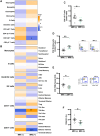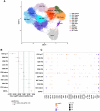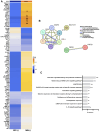Coronavirus disease 2019-related myocardial injury is associated with immune dysregulation in symptomatic patients with cardiac magnetic resonance imaging abnormalities
- PMID: 39073768
- PMCID: PMC11587552
- DOI: 10.1093/cvr/cvae159
Coronavirus disease 2019-related myocardial injury is associated with immune dysregulation in symptomatic patients with cardiac magnetic resonance imaging abnormalities
Abstract
Aims: While acute cardiovascular complications of coronavirus disease 2019 (COVID-19) are well described, less is known about longer-term cardiac sequelae. For many individuals with cardiac signs or symptoms arising after COVID-19 infection, the aetiology remains unclear. We examined immune profiles associated with magnetic resonance imaging (MRI) abnormalities in patients with unexplained cardiac injury after COVID-19.
Methods and results: Twenty-one participants {mean age 47 [standard deviation (SD) 13] years, 71% female} with long COVID-19 (n = 17), raised troponin (n = 2), or unexplained new-onset heart failure (n = 2), who did not have pre-existing heart conditions or recent steroid/immunosuppression treatment, were enrolled a mean 346 (SD 191) days after COVID-19 infection in a prospective observational study. Cardiac MRI and blood sampling for deep immunophenotyping using mass cytometry by time of flight and measurement of proteomic inflammatory markers were performed. Nine of the 21 (43%) participants had MRI abnormalities (MRI(+)), including non-ischaemic patterns of late gadolinium enhancement and/or visually overt myocardial oedema in 8 people. One patient had mildly impaired biventricular function without fibrosis or oedema, and two had severe left ventricular (LV) impairment. MRI(+) individuals had higher blood CCL3, CCL7, FGF-23, and CD4 Th2 cells, and lower CD8 T effector memory (TEM) cells, than MRI(-). Cluster analysis revealed lower expression of inhibitory receptors PD1 and TIM3 in CD8 TEM cells from MRI(+) patients than MRI(-) patients, and functional studies of CD8 T αβ cells showed higher proportions of cytotoxic granzyme B+(GZB+)-secreting cells upon stimulation. CD8 TEM cells and CCL7 were the strongest predictors of MRI abnormalities in a least absolute shrinkage and selection operator regression model (composite area under the curve 0.96, 95% confidence interval 0.88-1.0). CCL7 was correlated with diffuse myocardial fibrosis/oedema detected by quantitative T1 mapping (r = 0.47, P = 0.04).
Conclusion: COVID-19-related cardiac injury in symptomatic patients with non-ischaemic myocarditis-like MRI abnormalities is associated with immune dysregulation, including decreased peripheral CD8 TEM cells and increased CCL7, persisting long after the initial infection.
Trial registration: ClinicalTrials.gov NCT04412369.
Keywords: COVID-19; Immunophenotyping; Magnetic resonance imaging; Myocarditis.
© The Author(s) 2024. Published by Oxford University Press on behalf of the European Society of Cardiology.
Conflict of interest statement
Conflict of interest: none declared.
Figures








References
-
- Giacca M, Shah AM. The pathological maelstrom of COVID-19 and cardiovascular disease. Nat Cardiovasc Res 2022;1:200–210. - PubMed
-
- Zhou F, Yu T, Du R, Fan G, Liu Y, Liu Z, Xiang J, Wang Y, Song B, Gu X, Guan L, Wei Y, Li H, Wu X, Xu J, Tu S, Zhang Y, Chen H, Cao B. Clinical course and risk factors for mortality of adult inpatients with COVID-19 in Wuhan, China: a retrospective cohort study. Lancet 2020;395:1054–1062. - PMC - PubMed
Publication types
MeSH terms
Associated data
Grants and funding
LinkOut - more resources
Full Text Sources
Medical
Research Materials

